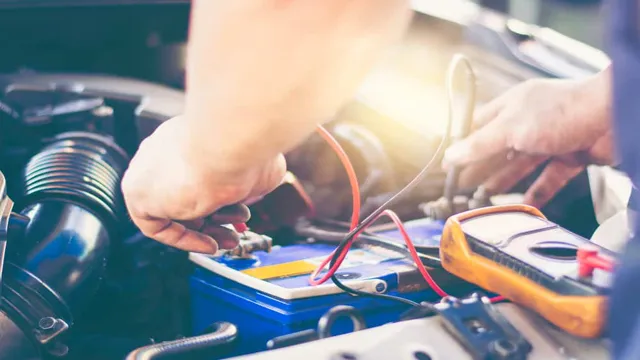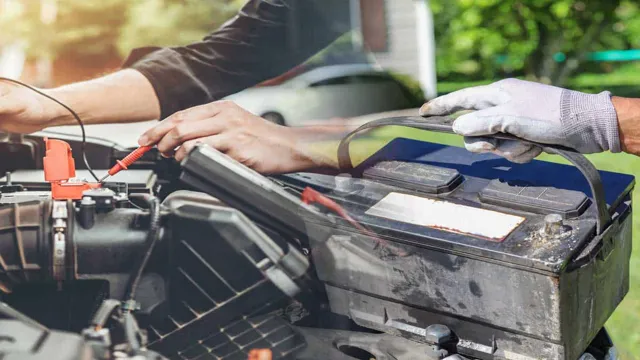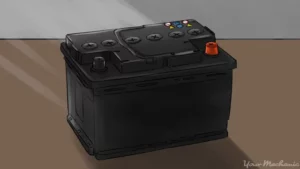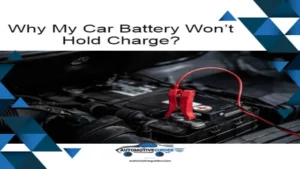Is your car battery having trouble starting? Before you start looking to replace your battery, you might want to first check if your battery charger is working properly. A car battery charger is a great tool to have on hand, as it can revive a dead battery and keep your car running smoothly. However, if your charger isn’t working properly, it won’t be able to serve its purpose.
Not sure how to check if your car battery charger is working? Don’t worry, we’ve got you covered. In this blog, we’ll go over some simple steps to help you determine whether or not your car battery charger is in good condition.
Tools and Materials
If you’re wondering how to check if a car battery charger is working, there are a few tools and materials you’ll need to have on hand. First and foremost, you’ll need a multimeter, which is a device that measures electrical voltage, current, and resistance. You’ll also need to have your car battery and charger, as well as a set of jumper cables to connect everything.
To start, connect the positive (red) cable from the charger to the positive terminal on the battery. Then, connect the negative (black) cable from the charger to a ground point on the car, such as the engine block. Next, use the multimeter to measure the voltage being output from the charger.
If it’s at the same level as the battery’s voltage, that means the charger is not working correctly. However, if there’s a significant difference in voltage, then the charger is working and charging the battery. Keep in mind that if the battery is severely discharged, it may take some time for the charger to bring it back up to a safe level of voltage.
Overall, checking if a car battery charger is working is a simple process that can save you time and money in the long run.
– Multimeter
If you want to get into electronics repair or just want to know the electrical values of certain objects, a multimeter is a must-have tool. Multimeters are used to measure voltage, current, and resistance, and provide accurate readings that allow you to troubleshoot electronics and electrical systems. Plus, they are affordable, so you don’t have to break the bank to get one.
When shopping for a multimeter, there are a few key things to consider. You’ll want to make sure the multimeter you choose can measure the specific electrical values you’re interested in, which may include AC/DC voltage, current, and resistance. You may also want to consider a multimeter with additional features like continuity testing, diode testing, and capacitance testing.
It’s important to note that while multimeters are relatively simple to use, they can be dangerous if you don’t know what you’re doing. Make sure to read the instructions carefully, and don’t attempt to measure anything that could pose a safety risk without proper training and protective equipment. With that said, a multimeter can be a valuable tool for anyone interested in working with electronics or electricity, helping you to diagnose and fix problems in a safe and efficient manner.

– Car battery charger
When it comes to car battery chargers, there are a variety of tools and materials that you should have on hand. First and foremost, you will need a reliable car battery charger. There are many different types of chargers available, including trickle chargers, fast chargers, and smart chargers, so be sure to choose one that fits your needs.
In addition to a charger, you will also need a set of jumper cables. These will come in handy if your car battery dies unexpectedly and you need a quick boost. Other essential materials include a battery tester, protective gloves, and a battery terminal cleaner.
It’s always a good idea to read the instructions carefully before you begin using any new tools and make sure that you properly store and maintain your equipment to keep it in good working order. With the right tools and some basic knowledge, you can easily keep your car battery charged and ready to go at all times.
– Battery
Battery maintenance is an important aspect of keeping your tools in top condition. There are several tools and materials that can help you achieve this. For starters, you will need a good quality battery charger that can handle the specific type of battery you are working with.
Most chargers are designed for a specific type of battery chemistry, such as lead-acid or lithium-ion, so be sure to choose the right one. You will also need a battery tester, which can help you identify any issues with your battery that may need to be addressed. Other materials you may need include a battery holder or tray, battery terminal cleaner, and a battery brush.
An important thing to keep in mind is that batteries can be dangerous if mishandled, so it is important to follow all safety precautions and manufacturer instructions when working with them. By properly maintaining your battery, you can extend its lifespan and ensure that your tools always have the power they need to get the job done.
Step-by-step Guide
If you’re wondering how to check if a car battery charger is working, there are a few things you can do to test it. First, make sure the charger is connected to the battery and is turned on. Then, check the battery voltage using a multimeter.
If the voltage is below 12 volts, the battery needs charging. Next, measure the voltage again after a few hours of charging. If the voltage has increased, the charger is working.
However, if the voltage hasn’t increased, there may be an issue with the charger or battery. Additionally, make sure to check the amperage output of the charger to ensure it is suitable for your battery. Overall, it’s important to regularly check and maintain your car’s battery and charging system to ensure it’s functioning properly.
– Step 1: Ensure safety
If you’re about to embark on any type of project that requires you to use power tools or heavy machinery, it’s essential that you prioritize safety from the outset. Before you even start planning or preparing for the job, take the time to assess the risks and hazards that could arise, and put measures in place to minimize them. This might include ensuring you have the necessary protective gear, such as hard hats, safety goggles, and sturdy work boots, as well as making sure you have a clear, safe workspace and adequate ventilation.
It’s also important to educate yourself on the proper use of your tools and machinery, and to never attempt to use a piece of equipment that you don’t feel confident with. Ultimately, the most important thing is to approach the job with a mindset focused on safety above all else. With this in mind, you can get to work confident that you’re taking the necessary steps to protect yourself and those around you.
– Step 2: Connect the charger to the battery
After ensuring that your charger is compatible with the battery, it’s time to connect the two. First, locate the positive (+) and negative (-) terminals on the battery. Then, take the positive cable from the charger and connect it to the positive terminal on the battery.
Repeat the process with the negative cable, connecting it to the negative terminal on the battery. It’s essential to ensure that the cables are firmly secured to the battery terminals to avoid any sparks or other accidents. Once the charger is connected to the battery, it’s time to plug it into an electrical outlet.
Be patient and allow the battery to charge fully before attempting to use it again. Remember to always follow the manufacturer’s instructions and safety precautions when handling and charging a battery. By following these steps, you can ensure a safe and effective charging process for your battery.
– Step 3: Check the charger’s display
When it comes to checking the display of your charger, it’s important to pay close attention to any notifications or warnings that may appear. First and foremost, make sure that the charger is properly connected to the power outlet and your device. Next, check the display for any error messages or icons that indicate an issue with the charging process.
It’s also a good idea to keep an eye on the charging progress and temperature, as overheating can be a dangerous problem. If you notice anything out of the ordinary, consider contacting the manufacturer or a trusted tech expert for assistance. Remember, the key to safe charging is staying vigilant and proactive.
So, make sure to check your charger’s display regularly and take action if any issues arise. Your safety and the safety of your device depend on it!
– Step 4: Use a multimeter to test voltage
When it comes to electrical work, safety is always a top priority. One essential tool that can help in ensuring safety is a multimeter. A multimeter is a device used by electricians to measure voltage, current, and resistance.
When testing voltage, the first step is to turn off the power to the circuit you’ll be working on. Then, insert the probes of the multimeter into the circuit and set the dial to the appropriate voltage setting. Double-check that the meter is set to measure AC or DC depending on what you’re testing.
Next, touch the probes of the multimeter to the circuit’s contacts. If the reading is too high, you may need to adjust the multimeter’s range to obtain an accurate reading. Remember always to use caution when working with electricity, and if you’re unsure about anything, it’s best to consult with a professional.
By following these steps, using a multimeter can be a great way to measure voltage and stay safe while doing so.
– Step 5: Compare readings
After taking readings from different scales in step 4, it’s time to compare them. This step is essential to ensure that the experiment results are accurate. To compare the readings, start by checking if they fall within the range expected for the particular measurement.
If they are not within the range, repeat the measurement and take the readings again. Next, check if all the readings are consistent and similar to each other. If the readings vary significantly, identify and eliminate any outliers that may be skewing the results.
Finally, calculate the average of all the readings to get the most accurate measurement possible. By following these simple steps, you can ensure that your experiment results are reliable and consistent.
Common Issues and Troubleshooting
If you suspect your car battery charger is not working properly, there are a few simple steps you can take to check it out. Start by plugging it into an outlet and turning it on. If the charger is working as it should, the LED lights on the charger should light up, indicating that it is charging your battery.
Another way to check is to use a voltmeter to measure the voltage of your battery before and after using the charger. If the voltage has increased significantly, then the charger is working properly. If you find that the charger is not working, try checking the fuse or ensuring that all connections are securely in place.
Remember, it is important to regularly check the condition of your battery to ensure it is functioning properly, and if you are unsure about the functionality of your charger, seek advice from a professional technician.
– Charger is not turning on
When your charger fails to turn on, it can be frustrating and put a damper on your plans. There are several common issues that can cause this problem, and thankfully, most of them are easily fixed. First, check to make sure that the charger is properly plugged in.
If it is, try plugging it into a different outlet or USB port to see if that makes a difference. Another possible problem is a damaged cord or port. If this is the case, you may need to replace the cord or take your device to a repair shop.
If your charger still won’t turn on, it could be a problem with the charger itself. Here, you may need to invest in a new charger. So, if your charger won’t turn on, don’t worry – it’s probably a simple issue that can be easily fixed.
By following these troubleshooting tips, you can quickly identify and solve the problem, getting your device charged and ready to go in no time. Remember to stay calm and patient, and don’t hesitate to seek help if you need it. With a little effort, you’ll soon be back to enjoying all the benefits of your powered-up device.
– Charger is not charging the battery
“charger not charging” One of the most frustrating issues with electronic devices is when the charger doesn’t seem to be charging the battery. There are several common reasons why this might happen. First, it could be a problem with the charger itself.
If the charger is damaged or defective, it won’t be able to properly charge your battery. Second, there could be an issue with the charging port on your device. If the port is dirty or damaged, it won’t be able to properly connect with your charger.
Finally, it could be an issue with the battery itself. Over time, batteries can degrade and become less able to hold a charge. If your battery is old or damaged, it may not be able to accept a charge from your charger.
To troubleshoot this issue, try using a different charger and cleaning the charging port. If those solutions don’t work, you may need to replace your battery or the charging port on your device.
– Charger is producing a burning smell
If your charger is producing a burning smell, it’s essential to take immediate action to avoid potential danger. One of the most common reasons why a charger produces a burning smell is due to overheating. Overheating can occur when the charger is operating at a high temperature level or because of the presence of dust or debris.
The best troubleshooting steps you can take to prevent this issue is to check for any obstructions, clean your charger regularly, and avoid chargers that don’t meet safety standards. If the problem persists even after following these steps, it’s best to contact the manufacturer or purchase a new charger as the issue may lie within the wiring and require professional expertise. Remember to always prioritize your safety, and never ignore any signs of burning smells or overheating.
– Charger is giving inconsistent readings
If your charger is giving inconsistent readings, there could be a few different things contributing to the issue. First, make sure the charger is properly plugged in and connected to your device. If it’s a wireless charger, check that your device is properly aligned with the charging pad.
If the connection looks good, try cleaning the charging port on your device or the charging pad on the charger. Dust, dirt, or debris can interfere with the charging process. If that doesn’t solve the problem, it’s possible that the charging cable or adapter is faulty and needs to be replaced.
It’s always a good idea to use the manufacturer-provided charger for your device to ensure optimal performance.
Conclusion
Just like trying to find the perfect soulmate, determining if your car battery charger is working requires patience, attention to detail, and a little bit of elbow grease. Take the time to carefully inspect the battery charger, read the instructions, and test it out on a battery. And if all else fails, just remember: if the charger is as dead as your love life, it’s time to move on and find a new one.
“
FAQs
1. How do I know if my car battery charger is working properly? A: You can use a multimeter to check the voltage output of the charger. If the voltage matches the charger’s rating, then it’s working fine. 2. Is it safe to leave the car battery charging overnight? A: No, it is not recommended to leave the battery charging overnight as it can cause overcharging and damage to the battery. 3. How long does it take to charge a car battery with a charger? A: It depends on the capacity and condition of the battery. On average, it takes 6-8 hours to fully charge a car battery with a charger. 4. What should I do if my car battery is not holding a charge? A: You can try recharging the battery with a charger and see if it holds the charge. If it doesn’t, then it may be time to replace the battery. 5. Can I use a car battery charger for other types of batteries? A: No, car battery chargers are designed specifically for lead-acid batteries, which are commonly used in cars. 6. How often should I charge my car battery with a charger? A: It is recommended to charge your car battery once a month if it’s not being used regularly. 7. What is the difference between a trickle charger and a regular charger? A: A trickle charger provides a low current to the battery to keep it charged over an extended period. A regular charger provides a higher current to charge the battery faster.






